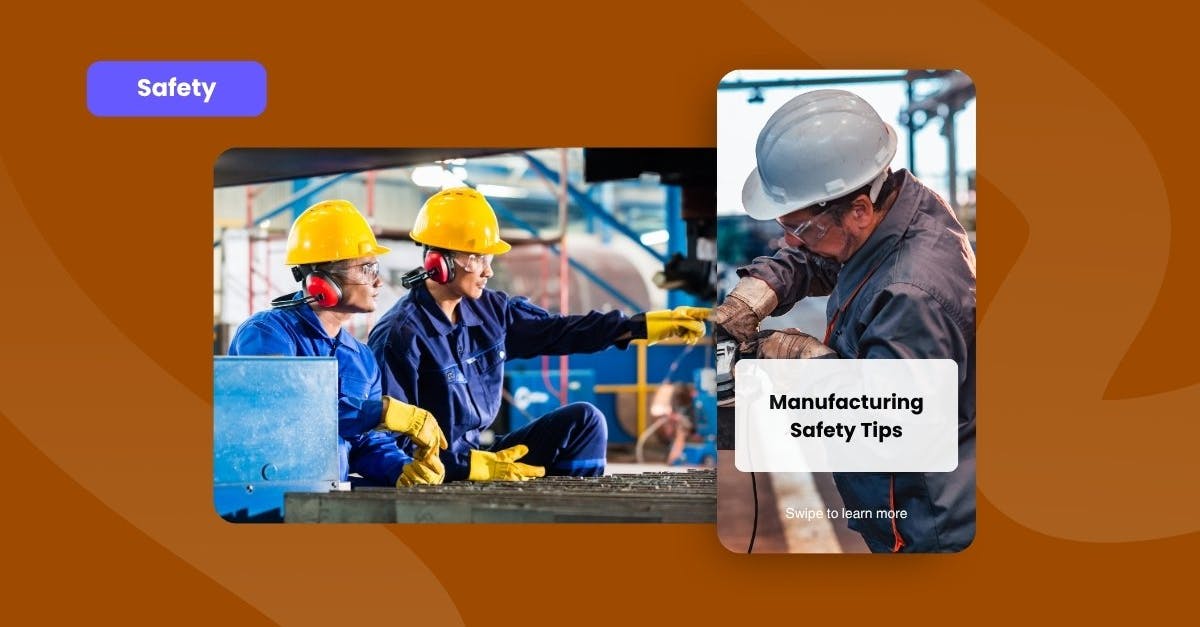10 Essential manufacturing safety tips

Safety practices significantly impact the quality and productivity of manufacturing businesses. To enhance employee engagement, optimize resource utilization, and improve cost efficiency, here are 10 essential manufacturing safety tips.
What is manufacturing safety?
Manufacturing safety refers to all the standard procedures, health measures, and workplace policies that production operations implement to protect their employees.
This involves upholding site practices that minimize safety risks related to manufacturing tasks, materials, equipment, and facilities. It allows your team to prevent incidents and injuries that could harm lives and productivity.
Manufacturing health and safety strategies are essential for sustainable success in the industry. They keep your crew members active, engaged, and compliant with regulations, resulting in increased productivity. Not to mention, these measures can reduce the cost of violations, accidents, and shutdowns, saving you resources.
Top 10 manufacturing safety tips
Let’s break down the essential safety tips for manufacturing work and improve overall quality.
1. Deliver continuous training
Manufacturing training is one of the most effective steps you can take to enhance your organization’s safety culture. It teaches, improves, and updates your team’s skills, so they can perform their tasks with care and accuracy.
Well-planned training sessions are the perfect opportunity to discuss key manufacturing safety topics, equipping employees to manage the hazards they can face at work. They can enhance their knowledge of risk control protocols, safeguards, and inspection procedures.
To deliver the most effective and relevant training for your site, it’s best to:
- Base your training topics on job hazard analyses, reported safety issues, and workplace safety targets
- Mix various teaching methods like eLearning, demonstrations, and simulations to cover different processes properly
- Create and share learning guides and reference materials
Use a training platform, like SC Training, that combines the best learning tools and techniques for efficient implementation
2. Promote proper use of equipment, tools, and machines
Each part and mechanism in any manufacturing equipment or machine serves a specific purpose. Any misuse or irresponsible practices can likely result in instrument failures, which can lead to major accidents.
Using manufacturing apparatuses solely for their designed use can significantly reduce injuries, as well as expensive breakdowns and repairs. Additionally, maintaining a safety check routine not only preserves lives but also extends the service life of your resources.
Some of the best manufacturing safety tips related to equipment, tools, and machines are:
- Implementing clear and accessible standard operating procedure (SOP) solutions
- Handing out manuals and guides, preferably digital, for ease of use and security
- Authorizing instrument use to well-trained operators only
- Organizing pre-op discussions to review safe practices
3. Empower early reporting and prompt action
Work sites with open communication systems for flagging safety issues and addressing concerns can resolve many more manufacturing challenges related to employee health. When your crew members feel encouraged to report work risks, the organization can continuously improve production conditions before incidents occur.
Valuable strategies to boost reporting and documentation include:
- Regular refreshers on the channels and processes in place to bring up problems
- Acknowledge team members who make the initiative to report issues
- Fix the raised challenges as soon as possible to show that there’s merit in communicating difficulties
4. Encourage timely breaks
Exhausted workers are more likely to make mistakes, skip safety steps, or overlook concerning issues. Not to mention, severe fatigue can lead to illnesses, resulting in increased absenteeism.
Giving your employees timely breaks helps them stay alert and productive. It allows them to refocus and remain engaged in their tasks.
To keep teams active, try implementing these strategies:
- Facilitate flexible and reasonable break-time policies
- Train your team leaders and managers to support employee breaks
- Discourage overworking
- Break the negative perception towards breaks
5. Conduct pre-work safety briefings
Pre-work safety briefings are quick, relatively easy measures to enhance hazard management and control amongst your teams. They offer opportunities to review key protocols, processes, and policies related to the day’s tasks.
The advantage is that these safety talks take place right before work, so essential information is top of mind for everyone. However, remember that these briefings should only be taken as a supplement to your safety management system.
Here are a few pre-work safety briefing practices to keep in mind:
- Give your crew members chances to ask questions, share experiences, and clarify information
- Keep your briefings short and focused
- Incorporate aids such as images, videos, and short quizzes to enhance comprehension, like SC Training’s bite-sized lessons from their course library.
6. Require personal protective equipment always
Monitoring your team’s compliance with PPE guidelines maximizes their overall defense against occupational risks. Teams must be in the correct safety gear before approaching any work area, equipment, or tool.
It’s your responsibility to monitor what employees choose to wear, how they don their equipment, and their methods for disposal and storage. Additionally, make it a point to check if their protective gear meets quality standards and is suitable for the duration of use.
7. Use checklists to standardize tasks
Given the many steps involved in each manufacturing task, it's easy to overlook a procedure or two. This exposes your teams to more risks, as a missed process can compromise safety and quality.
Implementing regular inspections and supplying your employees with checklists helps them complete work protocols accurately and thoroughly. They’re especially valuable for assessing the condition of materials, facilities, equipment, and work, making safety verifications more effective.
SafetyCulture offers mobile checklist solutions that empower employees to perform their jobs correctly on the first attempt. SC Training also features practical assessment tools, such as text boxes and ratings, to standardize worker evaluations across various settings.
8. Address slips, trips, and falls
Slips, trips, and falls are among the most common causes of workplace accidents, and it’s no different in the manufacturing industry. The advantage is that addressing this safety risk is straightforward and can greatly improve workplace conditions.
The key approach to prevent slips, trips, and falls is regular housekeeping on site. This includes:
- Eliminating clutter
- Cleaning surfaces, free of drippings and grime
- Fixing loose boards, uneven surfaces, and holes
- Using drip pans
- Installing railings
- Lighting work areas properly
- Placing signage and markers
9. Apply ergonomic principles
Health and safety in manufacturing should also prioritize the integrity of employees’ biomechanics. Many occupational injuries and long-term physical ailments result from strenuous movements that could’ve been avoided through safe ergonomic principles.
What does this look like in practice? Ergonomic manufacturing skills can be applied by:
- Training teams to use proper lifting techniques
- Encouraging crew members to use lifting aids and mechanical support
- Implementing load assessments
- Improving workplace layouts
- Facilitating the even distribution of workloads per employee
10. Keep work areas organized, clean, and secure
The quality of work is directly influenced by the environment in which it takes place. It’s difficult to expect high productivity when the site’s conditions are unsafe and disorganized.
Crews are more likely to work confidently and efficiently when they feel secure and orderly in their environment. Here are manufacturing safety tips to keep facilities well-maintained and well-structured:
- Store tools and materials in their proper places
- Shut off machines completely when not in use
- Eliminate flammable debris and objects
- Make hazard communication instructions for toxic objects and substances visible
- Clean out potentially cross-contaminated surfaces
- Create enough space that doesn’t cramp equipment and employees
Keep workplace instructions and guides in a centralized storage, like SC Training’s file briefcase, where teams can always reference procedures
Author
Mackie Angat
Mackie Angat is a content specialist at SC Training, a frontline training platform dedicated to helping businesses achieve operational excellence. He brings knowledge and insights in compliance training, industrial safety, and quality management, allowing him to create content that addresses the needs and challenges of the construction and manufacturing industries. Outside of work, Mackie enjoys working out, exploring music, and watching films.
